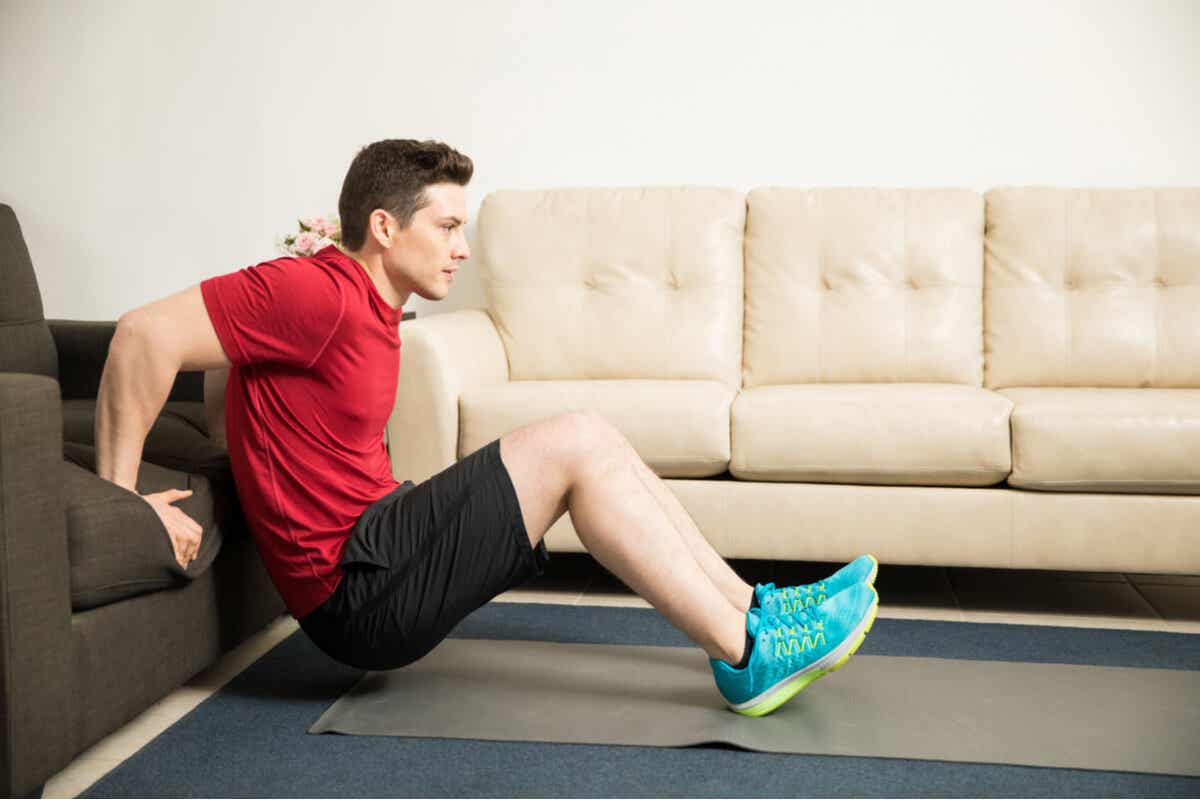Tricep Dip Exercises: Characteristics and Variations

Tricep dip exercises are an activity that allows muscle development in the chest, back (high and low), and triceps. Their benefits, in addition to gaining muscle, are found in the increased strength and the possibility of working opposing muscle groups at the same time.
There are some elements to keep in mind to obtain the results you desire, reduce the risk of injury, and amplify the field of action. So, keep reading and find out how to do triceps dips perfectly!
What should I keep in mind before I start?
To lay solid foundations before performing tricep dip exercises, we’ll talk about three fundamental pillars. We’re referring to the necessary equipment, the grip, and the objectives of the routine, depending on the level of the performer.
1. Necessary equipment
The first thing to define is the essential equipment. For example, tricep dip exercises require parallel bars and dip bases or dip stations. In addition to this, a dip belt and weight plates must be part of the activity.
There are smaller-sized options than those offered by gyms so that you can work out from home. Also, some variations allow the use of benches with high stability to accelerate your adaptation to higher demand.

2. The grip
A balanced grip that promotes the expected muscular increase is based on the principle of the maximum separation allowed by the hands. This should not exceed the length of the forearm of the person involved in physical conditioning.
If this distance is exceeded, problems will begin to occur due to the displacement of tension, passing from the triceps to the shoulders. This increases the risk of injury due to an accumulation of loads with each repetition.
3. Routine objectives
As in every exercise, it’s recommended to set goals consistent with the level of preparation that the person has. Therefore, the following goal guide with varying difficulties is a way to evaluate gradual evolution:
- Beginners: 5 repetitions that are assisted with a resistance band, using a tempo of 2131.
- Intermediate level: 5 repetitions without assistance at a tempo of 2131.
- Advanced: The possibility of exceeding 10 repetitions at a tempo of 1121.
- Expert: Exceeds 15 repetitions at a tempo of 1121.
You may be interested in: Muscle-Strengthening Exercises in Children: Everything You Need to Know
How to do the core exercise correctly
Now it’s time to explain how to perform tricep dip exercises. The best way to apply do them correctly is to emphasize perfect technique during each step, without forgetting to include stretching.
For this reason, here are the steps you need to follow to achieve a safe execution:
- Tighten the dip belt around your waist. Remember that the area where the chain is placed should be facing forward. Place the end of the chain in the belt loop for adjustment purposes.
- Place the weight plate on the chain. When done, attach the chain to the opposite side of the belt so that the weight hangs down.
- Mount the dip bar (with the grip not exceeding the distance of the forearms), so that you’re facing forward. Keep your arms completely straight and stable. Don’t lose the imaginary alignment of your head with your torso as a guide. In addition, make it a priority that your wrists are in line with your forearms.
- Begin the descent of the body slowly along with a deep inhalation. The point of arrival is marked by bending the elbows at a 90-degree angle.
- As you feel considerable tension in the upper body, exhale and raise the body to the initial posture.
Depending on the objectives of your routine, the goal is to be able to accomplish 2 or 3 sets. Since this is such a physically demanding activity, a few minutes rest of rest are allowed between each set.
Variations for the routine
The variations are diverse, giving an abundance of possibilities to those who wish to do this type of exercise but don’t yet have all the basic equipment. Together, they serve as a preliminary stage of adaptation.
Dipping with bent knees
In the bent-knee dip, the essential equipment you’ll need is a bench, so it can be performed in any space. Then, do the following:
- Stand with your feet together in front of the bench or box.
- Position your hands on the bench as far apart as your forearm or shoulder-width apart and bend your knees.
- Lower as far as the naturalness of the movement allows and come back up quickly.
- Perform 3 sets of 10 repetitions.
Dive with straight legs
Again, you’ll opt for a bench or a box and repeat the series of steps that you would for the bent-knee dip. The only change is that the legs must be completely straight, in a position that increases the range available for the descent and ascent of the body.
Bench dips with leg lifts
The last variation we suggest requires two benches of different heights. Once you have them, you should continue as follows:
- Stand with your back to the higher bench and place your hands at the distance recommended above.
- Put your feet on the lower bench located in front of you, without your legs being completely straight.
- Gently lower yourself down as far as possible.
- Quickly return to the starting position.
- Perform 2 or 3 sets of 7 to 10 repetitions.

Beginning with tricep dip exercise variations
You should start with variations before resorting to the classic tricep dip exercise. In this case, you need to be able to complete a minimum of 10 repetitions of dips with your bent knees to be able to move on to the next level.
You should never forget the importance of keeping your abdominals flexed throughout the repetitions, which increases the ability to move in the face of the body load.
If the scenario comes up where you don’t have the preparation to start with triceps dip variations, then you can begin with strengthening exercises such as the dead hang, pull-ups, and push-ups.
All cited sources were thoroughly reviewed by our team to ensure their quality, reliability, currency, and validity. The bibliography of this article was considered reliable and of academic or scientific accuracy.
- Ali M, Sundaraj K, Ahmad R, Ahamed U, Islam M y Sundaraj S. Evaluación de la fuerza del músculo tríceps braquial durante el ejercicio de fuerza de agarre mediante electromiografía de superficie. Investigación biomédica. 2014.
- Tiwana M y Bordoni, B. Anatomía, Hombro y Miembro Superior, Músculo Tríceps. StatPearls. 2020.
- Davidson A y Rice C. Efecto del ángulo del hombro sobre el patrón de activación de los extensores del codo durante una contracción fatigante isométrica submáxima. Músculo y nervio. 2010.
- Landin D y Thompson M. La función de extensión del hombro del tríceps braquial. Revista de electromiografía y kinesiología , 21 (1), 161-165. 2011.
- You-Sin K, Do-Yeon K y Min-Seong H. Efecto del ejercicio de flexión de brazos a diferentes anchos palmar sobre las actividades musculares. Revista de Ciencias de la Terapia Física. 2016.
This text is provided for informational purposes only and does not replace consultation with a professional. If in doubt, consult your specialist.








